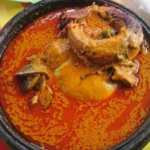When it comes to Zimbabwean cuisine, one dish that holds a special place in the hearts of its people is Sadza and Huku. This traditional meal showcases the flavors and culinary heritage of Zimbabwe, combining tender chicken stew with a staple food known as sadza, made from cornmeal. The result is a delicious and hearty dish that is cherished across the country.
Sadza is a thick porridge-like dish that serves as the foundation of many Zimbabwean meals. It is made by cooking finely ground cornmeal in water until it reaches a smooth and thick consistency. This process requires constant stirring and patience to achieve the desired texture. Sadza is often compared to other cornmeal-based dishes like polenta or ugali, but it has its own unique characteristics that set it apart.
The preparation of Sadza involves a traditional cooking method that requires skill and experience. The cornmeal is gradually added to boiling water, stirring continuously to avoid lumps from forming. As the mixture thickens, it is vigorously stirred with a large wooden spoon, a process known as “mushonga,” which helps to break down any remaining lumps and ensure a smooth and creamy texture.
Sadza is typically served in large portions on a communal platter, with diners using their hands to shape small balls or “sadza neNyama” (sadza with meat) to scoop up the accompanying dishes. The traditional accompaniments can vary but often include a variety of stews, relishes, or sautéed greens.
Huku, meaning “chicken” in Shona, is one of the most popular protein options to pair with Sadza. The chicken is simmered in a flavorful broth with onions, tomatoes, garlic, and a blend of spices. This slow-cooking process allows the flavors to meld together and results in tender and succulent chicken pieces. The aromatic chicken stew is then served alongside the Sadza, creating a satisfying and balanced meal.
The combination of Sadza and Huku embodies the essence of Zimbabwean cuisine. It represents the importance of staple foods like cornmeal and the cultural significance of communal dining. Sharing a meal of Sadza and Huku is not only a way to nourish the body but also a means of bringing people together, fostering a sense of unity and connection.
Zimbabwean cuisine reflects the country’s rich agricultural resources and cultural diversity. Sadza and Huku showcase the use of locally sourced ingredients and traditional cooking techniques, preserving the culinary heritage of the nation. This dish has been passed down through generations, with each family adding their own unique touch to the recipe.
If you have the opportunity to taste Sadza and Huku, you’ll experience a true taste of Zimbabwean culture. Allow the flavors to dance on your palate as you savor the creamy texture of Sadza and the rich, aromatic chicken stew. Embrace the spirit of togetherness that this dish embodies and immerse yourself in the flavors and traditions of Zimbabwean cuisine.








